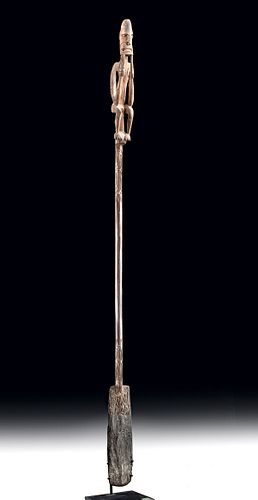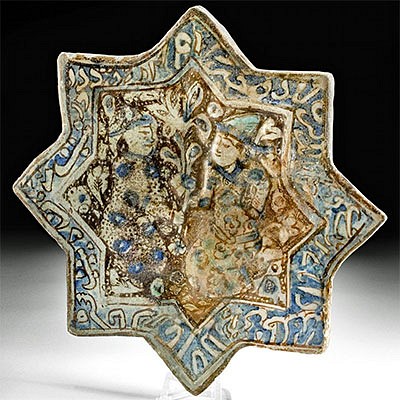20th C. Papua New Guinea Abelam Wood Canoe Paddle
Lot 312
About Seller
Artemis Fine Arts
686 S Taylor Ave, Ste 106
Louisville, CO 80027
United States
Selling antiquities, ancient and ethnographic art online since 1993, Artemis Gallery specializes in Classical Antiquities (Egyptian, Greek, Roman, Near Eastern), Asian, Pre-Columbian, African / Tribal / Oceanographic art. Our extensive inventory includes pottery, stone, metal, wood, glass and textil...Read more
Categories
Estimate:
$1,700 - $2,550
Absentee vs Live bid
Two ways to bid:
- Leave a max absentee bid and the platform will bid on your behalf up to your maximum bid during the live auction.
- Bid live during the auction and your bids will be submitted real-time to the auctioneer.
Bid Increments
| Price | Bid Increment |
|---|---|
| $0 | $25 |
| $300 | $50 |
| $1,000 | $100 |
| $2,000 | $250 |
| $5,000 | $500 |
| $10,000 | $1,000 |
| $20,000 | $2,500 |
| $50,000 | $5,000 |
| $100,000 | $10,000 |
| $200,000 | $20,000 |
About Auction
By Artemis Fine Arts
May 20, 2021
Set Reminder
2021-05-20 10:00:00
2021-05-20 10:00:00
America/New_York
Bidsquare
Bidsquare : Ancient & Ethnographic From Around The World
https://www.bidsquare.com/auctions/artemis-gallery/ancient-ethnographic-from-around-the-world-6979
Ancient art from Egypt, Greece, Italy and the Near East, as well as Asian, Fossils, Pre-Columbian, Native American, African / Tribal / Oceanic, Fine art, and much more! All categories, all price ranges... all legally acquired and guaranteed to be as described or your money back. Artemis Fine Arts info@artemisgallery.com
Ancient art from Egypt, Greece, Italy and the Near East, as well as Asian, Fossils, Pre-Columbian, Native American, African / Tribal / Oceanic, Fine art, and much more! All categories, all price ranges... all legally acquired and guaranteed to be as described or your money back. Artemis Fine Arts info@artemisgallery.com
- Lot Description
Oceania, Papua New Guinea, East Sepik River, Abelam, ca. mid 20th century CE. A gorgeous hand-carved wooden canoe paddle displaying a rectangular blade, a tubular shaft, and a grip in the form of an ancestor figure seated with his elbows on his thighs and his hands to his chin. Adorned with decorative incised striations throughout his body, the skillfully carved figure features wide hips, muscular legs, incised genitalia, a slender torso, square shoulders, lengthy arms, and sizeable hands. His stylized visage exhibits sunken ovoid eyes under a heavy brow, a long nose with a horizontally drilled septum, perhaps for tying a strap or ornament, and an enormous open mouth displaying top and bottom rows of teeth around a protruding tongue. A pair of naturalistic ears flanks his expressive face, sitting just below a hemispherical cap. Intricately carved patterns of abstract form decorate the bottom of the blade, the top of the shaft, and the area just below the figural grip. Size: 3.75" W x 60.5" H (9.5 cm x 153.7 cm); 62.5" H (158.8 cm) on included custom stand.
Papua New Guinea is known for its extremely rugged terrain. In fact, there are very few roads, and dugout canoes are the primary form of transportation along inland rivers such as the Sepik, the Fly, their tributaries, in addition to the extensive lagoons and swamps such as the Asmat. For this reason, a great deal of time and effort has been invested into the creation of canoes and canoe paddles like this example.
Provenance: private Newport Beach, California, USA collection
All items legal to buy/sell under U.S. Statute covering cultural patrimony Code 2600, CHAPTER 14, and are guaranteed to be as described or your money back.
A Certificate of Authenticity will accompany all winning bids.
We ship worldwide and handle all shipping in-house for your convenience.
#135726Minor surface fissure to top of figure's head. Expected abrasions to blade and a few nicks and light scratches throughout. Otherwise, intact and excellent with lovely patina.Condition
- Shipping Info
-
All shipping is handled in-house for your convenience. Your invoice from Artemis Gallery will include shipping calculation instructions. If in doubt, please inquire BEFORE bidding for estimated shipping costs for individual items.
-
- Buyer's Premium



 EUR
EUR CAD
CAD AUD
AUD GBP
GBP MXN
MXN HKD
HKD CNY
CNY MYR
MYR SEK
SEK SGD
SGD CHF
CHF THB
THB














